Decentralized Storage Report: What Pain Points Are Addressed by Projects like Filecoin, Arweave, and Storj?
Original Title: “Decentralized Storage Report: The Cornerstone of WEB3.0”
Author: Leon, MEKO CLUB
1. Overview of Internet Cloud Storage Business
Our society is currently experiencing an unprecedented explosion of information, with computers, smart devices, televisions, home security systems, wearable devices, cars, and even robots constantly generating and using data. With the development of AI and the Internet of Things (IoT), a massive group of devices will generate vast amounts of data. The future will be a digital age where data becomes the primary production factor, and the exponentially growing volume of data poses higher demands on the current data storage systems, which include services for data storage, management, and retrieval.
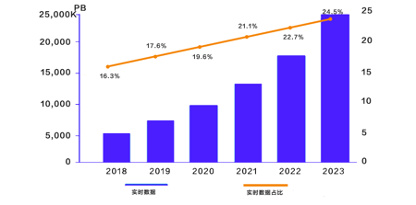
Global Real-Time Data Trend Preview Data Source: IDC
Traditional centralized cloud storage is a storage solution that places storage resources in the cloud for access. The business model of internet cloud storage as a service has been around for a long time, with Amazon Web Services (AWS) launched by Amazon in 2006, renting its servers and storage space to users, thus reducing the costs for developers to create and manage server infrastructure. Currently, the internet cloud service market is enormous, with a market size reaching $200 billion in 2021. Companies like Amazon, Microsoft, Google abroad, and Alibaba domestically represent the leading enterprises in centralized cloud storage.
The market share of various cloud service markets in 2021 is as follows:
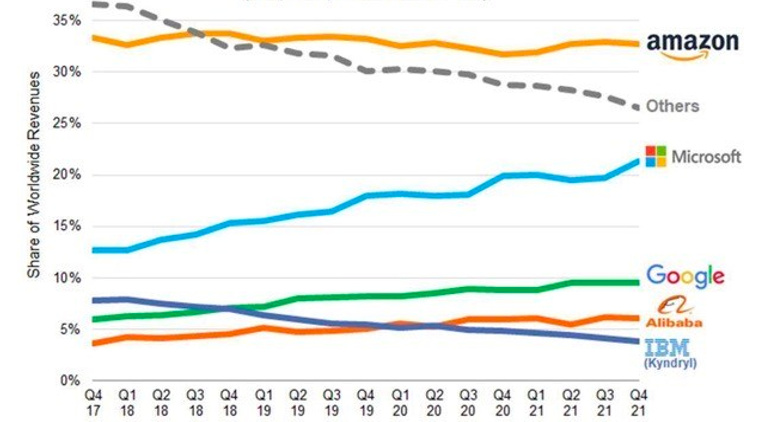
(Source: TelecomTV)
Among them, Amazon Web Services has long maintained its leading position in the industry, with revenues reaching $62 billion in 2021, accounting for about 33% of the cloud service market share. Microsoft ranks second, with remarkable growth in recent years, increasing its market share from 13% in 2017 to 21% in 2021. For Amazon Web Services, its four core departments are cloud computing, cloud storage, networking, and software, with revenue growth in each department as follows:
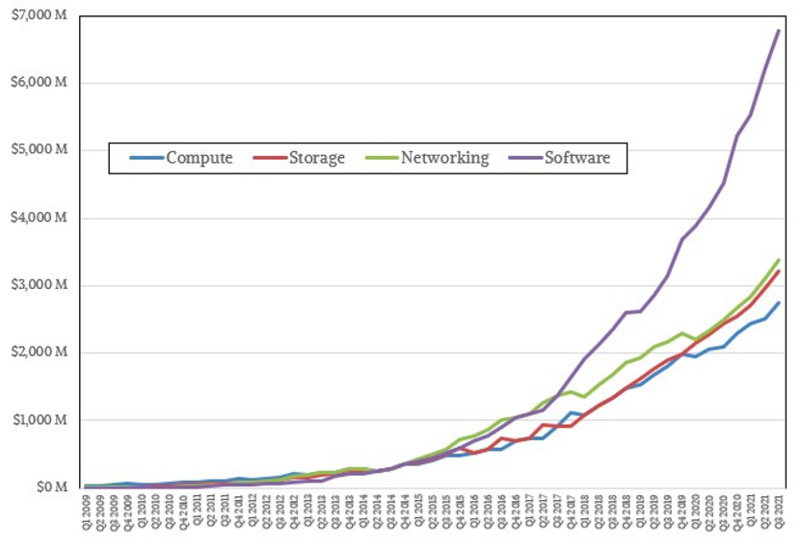
(Source: Amazon)
The data in the chart shows that the fastest-growing segment is software services, with revenues reaching nearly $7 billion in the third quarter of 2021. The growth curves and revenues of cloud computing, cloud storage, and network services are relatively close, around $3 billion, which has doubled compared to the revenue levels in 2018. In summary, in the era of big data, the market growth space for cloud storage remains vast.
2. Pain Points of Centralized Storage
As time progresses, the services of centralized cloud storage continue to improve, and prices keep decreasing. However, due to the centralization of data storage, which involves larger volumes of data, it makes data more susceptible to attacks and leaks. The security, privacy, and sustainability of centralized storage data pose certain risks, leading the industry to gradually hit a bottleneck.
Data security has two layers of meaning: the first layer is "ensuring data privacy is not leaked," and the second layer is "ensuring data integrity is not lost."
In the current centralized storage model, users upload all sensitive data, which not only causes users to lose control over their data but also shifts the risk of data leakage to the cloud storage operators. If these private information experiences data loss, damage, leakage, or theft, it could lead to significant losses for individuals, enterprises, and even society as a whole, damaging the reputation of cloud storage operators.
At the same time, cloud storage itself is merely a business model; centralized cloud storage operators may go bankrupt or cease operations due to various market or operational issues, while users have no means to impose constraints or claims against the service providers. This leads users to prefer storing data with larger, more reputable service providers, resulting in an increasing concentration of data among leading companies, which also creates a situation where significant data loss can occur if data is lost.
In terms of sustainability, the current centralized storage model has certain service limitations. With the proliferation of autonomous driving and IoT, a large number of smart devices will connect to the network and generate exponentially growing real-time data. In this context, centralized data storage clearly cannot meet the demands of network storage. Future data storage systems must not only achieve data storage, sharing, and retrieval but also ensure efficient and accurate data transmission and analysis, which poses significant challenges to centralized data storage structures.
In summary, the vulnerability of the centralized data storage model is somewhat detrimental to the development of the big data era. To fundamentally address the frequent data leaks, service limitations, and operator shutdowns of traditional centralized storage, the concept of decentralized/distributed storage has gradually emerged.
3. Why Decentralized Storage is Worth Attention
Decentralized Storage Network (DSN) is a storage business model that uses blockchain as the underlying technology to shard files or file sets and store them in storage space provided by suppliers through distributed storage. Decentralized storage is important because it addresses the various pain points of centralized cloud storage in Web2.0 and better aligns with the demands of the big data era, enabling the storage of unstructured edge data at lower costs and higher efficiency, empowering technologies like IoT and autonomous driving. Moreover, decentralized storage is the cornerstone of Web3 development.
3.1 Decentralized Storage Addresses the Pain Points of WEB2 Centralized Cloud Storage
As analyzed above, traditional internet centralized storage keeps all data on application platform servers, currently facing numerous issues such as user data security, ownership, privacy protection, and sustainability. The advantage of decentralized storage lies in its ability to replicate data across multiple locations and be accessed from various places, reducing the security risks of hackers attacking through a single node, effectively enabling data rights confirmation and privacy protection, and allowing users to have complete control over their data. Such security and privacy are not available in centralized networks. Additionally, projects like Arweave focus on the issue of permanent data storage, contributing to the long-term stability of important data storage. It can be said that the challenges faced by centralized storage are the opportunities welcomed by decentralized storage.
3.2 Distributed Storage is Suitable for Unstructured Edge Data
Structured data refers to content stored in traditional relational databases, while unstructured data includes images, audio, video, documents, and other data stored in ordinary file formats. According to IDC reports, 75% of future data increments will be unstructured edge data. Unlike centralized cloud storage services, distributed storage can migrate data storage from distant cloud servers to edge storage devices or edge data centers closer to the data, resulting in lower network communication overhead, interaction latency, and bandwidth costs, as well as higher adaptability and scalability, making it suitable for handling large quantities of fast storage.
3.3 Cost Advantages of Decentralized Storage
Decentralized data storage, especially for unstructured data, has significant cost advantages. Distributed storage changes the production relationship through nodes and token rewards, allowing end users to use storage, indexing, and other services at very low prices. For example, storing NFTs on the IPFS network incurs almost no cost. In contrast, traditional internet cloud storage services, such as Baidu Cloud, have very high centralized operational costs. Therefore, from a cost perspective, decentralized storage has a clear competitive advantage.
3.4 Decentralized Storage as the Cornerstone of WEB3.0
Decentralized storage is one of the earliest and most focused infrastructures in the Web3 field. The earliest decentralized storage solutions, Storj and the IPFS protocol, were launched in 2017. Without distributed storage, there would be no decentralized network, and certainly no Web3.0. Projects that only offer decentralized services without underlying decentralized storage support cannot strictly be considered Web3 projects. Therefore, decentralized storage is a cornerstone that empowers the long-term development of Web3, which is of great significance.
In summary, decentralized storage not only addresses the issues of traditional centralized storage but also serves the data storage needs of traditional industries in the big data era while empowering the emerging Web3.0. As an important infrastructure in the crypto field, the business model of the decentralized storage track is clear and distinct, with the market size showing a significant growth trend, making the entire market profitable for miners and investors. With the development of the Web3 ecosystem and the emphasis on privacy and user data ownership, the decentralized storage field will bring significant returns.
4. Development Process of Decentralized Storage

(Source: ASMP)
The different stages of decentralized storage development have addressed various issues:
Storj and Sia achieved P2P supply-demand matching through smart contracts, suitable for large-scale data storage, but essentially they are just connecting storage resources, lacking effective content addressing methods, which is not conducive to file sharing, such as movies and audio.
IPFS achieved file addressing, marking a significant innovation in the underlying protocols of the internet. Projects like Filecoin and Crust have built IPFS storage networks through incentive layers, thus providing stable decentralized storage services.
Arweave has achieved permanent storage of files through an innovative consensus mechanism.
The Ceramic database storage protocol launched in 2021 can meet high-frequency data demands. Stratos has introduced a Web3 decentralized infrastructure that integrates blockchain, storage, and computing.
However, even after five years of development, decentralized storage is still in its initial stages. Currently, Filecoin's effective storage capacity is 59.6 PB, and Arweave's total storage capacity has reached 76.3 TB. According to Web3 Index data, Arweave's storage fees over the past 90 days amounted to $185,000, while Storj's fees were $55,000. It is evident that in terms of both storage scale and performance, decentralized storage currently falls far behind centralized storage. However, based on the various advantages of decentralized storage, there is still significant growth potential in this track, which will unleash more possibilities.
5. Filecoin Project Analysis
5.1 What is Filecoin?
Before understanding Filecoin, we need to understand IPFS.
IPFS (InterPlanetary File System) is a decentralized network underlying protocol launched in 2015, primarily aimed at supplementing or even replacing the internet's Hypertext Transfer Protocol (HTTP). The IPFS protocol defines how files are stored, retrieved, and transmitted in a distributed system, allowing for permanent, decentralized preservation and sharing of files. It is a content-addressable, peer-to-peer distributed protocol. IPFS has a grand vision of serving as the storage layer for Web 3.0 and establishing a new internet architecture. Currently, over 5 billion files have been uploaded to IPFS, and more than 100 blockchain projects have adopted IPFS for data and file storage, making it one of the essential infrastructures of decentralized networks.
Filecoin is an incentive mechanism and public chain system based on the IPFS protocol, establishing an open decentralized storage network to store data from around the world. It serves as both the storage layer for IPFS and the incentive layer for the IPFS protocol, with IPFS being the application layer of the entire system. Both Filecoin and IPFS are developed by Protocol Labs, and the two protocols share multiple functional modules.
Based on its model, Filecoin can be seen as the Airbnb of data storage, renting out excess data storage space from servers worldwide to save data on a monthly basis. Its network implements a complete storage and retrieval economy, serving as the foundation for various differentiated services. Filecoin raised over $250 million at its launch in 2017 and officially launched its mainnet in October 2020.
The Filecoin network ecosystem mainly consists of independent miners (participants providing network storage capacity) and storage service clients who hire miners. Miners provide storage space, using effective storage as computing power, participate in network governance, and compete for block packaging rights. There are two types of miners in the network: retrieval miners and storage miners. Retrieval miners earn retrieval fees, while storage miners earn storage rent and block packaging rewards. Every participant in the ecosystem can play a role, and the underlying protocol encourages network participants to engage in behaviors beneficial to the network. Storage service clients can hire miners through two distributed, verifiable, incentive-based markets: the storage market and the retrieval market. Miners are key contributors to the project's ecosystem development, and the investments of token holders in miners and developers are also crucial for ecosystem growth.
In Filecoin's open economy, anyone can become a storage miner, but miners are only eligible for rewards after loading a certain amount of storage onto the network. Onboard storage serves as proof of the network's reliability and capacity; if these storage commitments are violated, the network will lose credibility. Therefore, miners promising capacity to the network must pledge Filecoin tokens (referred to as FIL) as collateral to prevent the possibility of miners failing to fulfill their commitments. In return for taking on this risk, storage miners are eligible for block rewards, which are paid to them in proportion to the amount of storage they provide to the network. Storage miners can also engage in collateral transactions with clients, where clients pay them FIL in exchange for storing specific data.
Filecoin adopts a hybrid consensus mechanism: Expected Consensus + PoRep (Proof of Replication) + PoSt (Proof of Spacetime).
PoRep (Proof of Replication) refers to storage service providers proving to verifiers that they are storing the corresponding data on a specific device, while PoSt (Proof of Spacetime) is PoRep plus timestamp and related technologies, proving that the storage service provider has stored data for a certain period. Filecoin's consensus mechanism is similar to PoS (Proof of Stake), but it replaces the proof of stake with proof of storage. However, the storage service providers capable of generating new blocks need to lead the selection of storage service providers within a cycle, which is the Expected Consensus.
The selected leading storage service provider will broadcast the new block they create to the network to obtain block rewards. Filecoin's consensus mechanism indicates that each storage service provider needs to keep their storage contributions at the forefront of the network to gain the right to block rewards, which incentivizes participants to continuously maintain the network.
Filecoin's hybrid consensus mechanism has two advantages over traditional consensus mechanisms: first, high network transaction efficiency. There is no need for extensive calculations; storage service providers only need to use storage space to obtain corresponding rewards, effectively preventing waste of costs incurred by storage service providers. Second, it effectively prevents blockchain forks. Filecoin uses a staking mechanism and storage space weight to ensure that storage service providers select the most effective chain while imposing corresponding penalties on storage service providers that fork.
5.2 Filecoin Token Economics
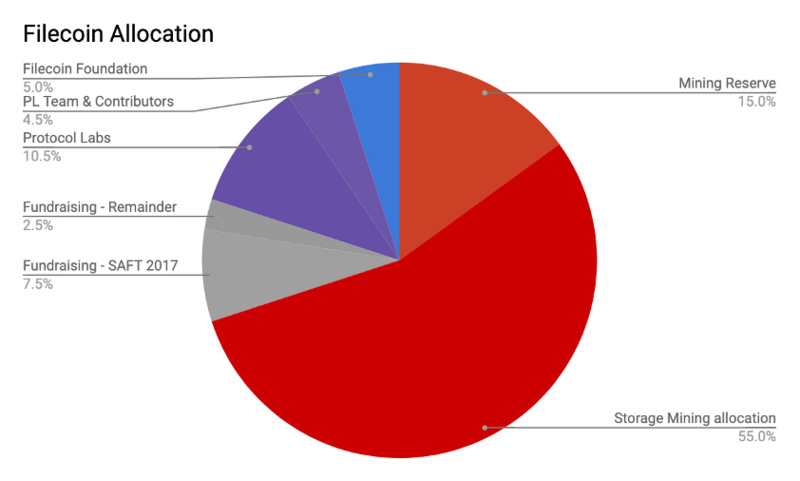
(Source: Filecoin)
The ecological token of Filecoin is FIL, with a fixed maximum supply of 2 billion FIL.
70% of the total token supply (1.4 billion tokens) is used to reward miners, divided into:
--- Simple Minting: 330 million FIL tokens released over a 6-year half-life based on time. The 6-year half-life means that 97% of the tokens will be released in about 30 years.
--- Benchmark Minting: 770 million FIL tokens, the main portion of miner reward tokens, minted based on network performance growth. These tokens will only be fully released if the Filecoin network reaches a Yottabyte storage capacity within 20 years.
--- Mining Reserve: 300 million FIL tokens are reserved to incentivize future mining types. The community will decide how to release these tokens and which stakeholders should be incentivized, but currently, this portion of the total supply is reserved.
The Filecoin Foundation holds 5% (100 million), Protocol Labs 15% (300 million), SAFT investors 7.5% (150 million), and other early investors 2.5% (50 million).
Token vesting period:
Miners immediately receive 25% of the rewards, while the remaining 75% unlocks linearly over 180 days. Block rewards received by unreliable storage nodes will be reduced and burned. The mining reserve has not yet been released and will be allocated by the community. According to Filescan data from August 23, 2022, miners produce approximately 290,000 tokens daily.
The 150 million FIL for SAFT investors is subject to linear vesting terms of 6 months, 1 year, 2 years, and 3 years, distributed as follows:
--- 58% of SAFT tokens unlock linearly over 3 years,
--- 5% of SAFT tokens unlock linearly over 2 years
--- 15% of SAFT tokens unlock linearly over 1 year
--- 22% of SAFT tokens unlock linearly over 6 months
The Filecoin mainnet launched on October 15, 2020, and nearly two years later, 63% of the SAFT tokens are still unlocking, with a daily unlocking amount of approximately 150 million * (0.58/3365 + 0.05/2365) = 89,726 tokens.
The 100 million FIL from the Filecoin Foundation will unlock linearly over six years, averaging 45,662 tokens daily.
The 300 million FIL from Protocol Labs will also unlock linearly over six years, averaging 136,986 tokens daily.
According to data from August 24, the near 24-hour staking amount = 5.72354 FIL / TiB * 6551.5 TiB = 38,070 tokens.
Note: The total circulating supply on Filescan equals the total token inflow (including mining rewards, vested SAFT tokens, paid mining reserves, and tokens originally held by the Filecoin Foundation and Protocol Labs) minus the total token outflow (including tokens locked on-chain or burned). Websites like CoinMarketCap and CoinGecko use their specific definitions to define circulating supply to standardize comparisons between projects. They only consider vested tokens from project teams (e.g., Filecoin Foundation, Protocol Labs, and project team members) as part of the circulating supply when these tokens are transferred from their original wallets. Therefore, the circulating supply of Filecoin defined by cryptocurrency price and market cap websites may be lower than the supply returned by the native Filecoin protocol API.
5.3 Filecoin Outlook Analysis
Filecoin directly competes with major players in the traditional cloud storage industry, aiming to provide a cheaper alternative to disrupt the centralized cloud storage industry dominated by large companies like Amazon, Google, and Alibaba. In the second quarter of 2022, Filecoin's revenue was $5.7 million, a 118% increase from the first quarter. In terms of pricing models, it is fundamentally similar to traditional storage, charging on a monthly basis. For Filecoin to succeed in the cloud storage market, it needs to be able to compete on price. Even though due to its network's security and decentralized nature, Filecoin may charge a certain premium in the long term, large centralized companies still have significant competitive advantages in economies of scale, allowing them to continuously lower prices. In the short term, it remains challenging for decentralized cloud storage providers represented by Filecoin to overtake their centralized counterparts.
Competitive Advantages:
The project has a massive scale and abundant funding, with a currently complete ecosystem that is conducive to expanding application scale.
Under Filecoin's mechanism, the entire network pays miners' hardware costs through block rewards to provide storage services. Storage services are matched through bidding, which helps reduce storage service prices.
Competitive Disadvantages:
Filecoin mining hardware requirements are high, making it impossible for ordinary users' personal computers to participate in mining, leading to a risk of centralization in large data centers.
Given the current download speeds of the IPFS network, its performance and speed need further improvement to meet enterprise-level service requirements.
6. Analysis of Other Projects in the Track
6.1 Arweave
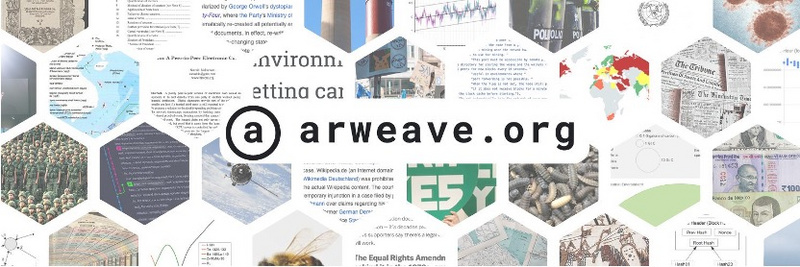
The Arweave project was founded in 2017, with its mainnet launched in June 2018. It focuses on one-time payments for permanent file storage, providing a storage solution called Permaweb, which utilizes the immutable nature of blockchain to directly write content into blocks for storage, achieving true permanent data storage for the first time. Currently, the internet loses 95% of its information every 20 years. Arweave aims to solve how to store data reliably over the long term, incentivizing miners to store history forever and share it upon request using Proof of Access (POA). Miners earn rewards from new block rewards while also receiving rewards from randomly selected old blocks in the storage chain, meaning the more blocks miners store, the more rewards they earn.
Arweave does not create a blockchain but rather a blockweave, similar to woven fabric connected by multiple threads. The blockweave connects multiple links throughout the data storage. For example, the only way to add new data to the blockweave is if the server can call a randomly selected file (or group of files) already on the blockweave. Only those servers that can call this previously random block can store any new data. This innovation in data storage and new economic incentives for miners create conditions for long-term data preservation.
The arrival of Blockweave also unlocks several new functionalities for data storage. First, it makes data both immutable and undeletable. If copies of files are replicated countless times across servers worldwide, it becomes nearly impossible to alter any files uploaded to the permanent network.
Second, payment for storing data no longer requires monthly payments. Instead, the permaweb operates on a one-time payment basis. The invention of data permanence also allows Arweave to enable others to build a permanent application ecosystem that can solve innovative problems on top of the Arweave protocol, which is also Arweave's greatest potential and primary focus—incubating more permanent web applications that interact with its protocol.
The potential of these permanent applications will be enormous for both developers and users. Arweave refers to these permanent web applications as profit-sharing applications because they share the same attributes as Arweave itself: they are permanent, token-based, and governed by the community, with economic incentives that align with developers and users rather than enterprises. Similar to cooperatives, these profit-sharing communities aim to "share" profits between application developers, users, and token holders. The profit-sharing community changes the incentive structure of applications to establish better alliances between developers and users, allowing both parties to participate more fully in the success of the applications.
Arweave's revenue in the second quarter of 2022 was $193,000, a 31% increase from the first quarter.
Project Advantages:
Arweave focuses on one-time payments for permanent file storage, filling a market gap. Fundamentally, Arweave addresses the issues of limited freedom of speech, excessive censorship, and ease of tampering on the current internet. At the same time, Arweave can help institutions store complete, immutable knowledge and information, such as for storing climate change databases. Currently, Arweave is collaborating with the National Oceanic and Atmospheric Administration (NOAA) to permanently store ongoing carbon measurement values to test the Permaweb.
Arweave claims to provide a data storage cost that declines similarly to Moore's Law, with users only needing to make a one-time prepayment (about half a cent per megabyte), while the interest generated from overpayments will help subsequent storage services continue to decrease. Arweave founder Sam Williams stated, "In recent years, the cost of Arweave data storage has decreased by an average of 30% annually. As long as this rate does not fall below 0.5% (based on current storage demand), the decentralized network can still afford the costs, and today's payments will cover the costs of storage space for the next 200 years."
From a technical perspective, Arweave's mining uses the RadomX algorithm, while also introducing parameters for block completeness. Given that Arweave's characteristics dictate that its block size will increase exponentially with network usage, considering the ever-expanding block data, future nodes may face the risk of being unable to store complete block data. Therefore, the introduction of the block completeness parameter does not require all nodes to store complete block data, and competition for block packaging is based on the number of blocks stored by each node.
Project Disadvantages:
Arweave's features can be applied primarily to data preservation centered around HTML5 web pages, establishing decentralized H5-APPs. However, in practical use, the application scenarios for issuing such certificates are relatively narrow. Currently, it can be observed that the majority of stored content on Arweave consists of screenshots of anti-government statements from Twitter, and the increasing number of explicit anti-government applications is concerning.
At the same time, Arweave's characteristic of being immutable poses significant challenges in program development, as developers must ensure that any program uploaded to Arweave contains no errors. If there is an error, even a punctuation mark, all previously uploaded content must be discarded and re-uploaded, inevitably leading to a large accumulation of useless garbage. Additionally, due to the openness of the blockchain, content uploaded to Arweave is accessible to the entire society, making it unsuitable for personal content uploads.
Finally, Arweave's focus on one-time payments for permanent file storage is a relatively simple model, which carries a certain risk of triggering the emergence of homogeneous projects that utilize the same storage concept and engage in price wars.
6.2 Storj
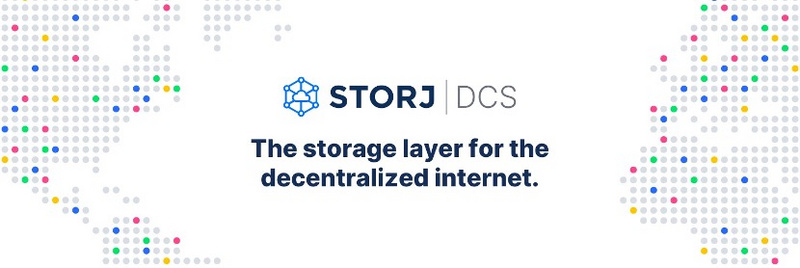
Storj was founded in July 2017 and is a distributed cloud storage protocol based on Ethereum, developed by the for-profit company Storj Labs. Storj aims to build a decentralized cloud storage platform that is censorship-resistant, surveillance-free, and always online. By utilizing idle hard drives and bandwidth, data can be negotiated, transmitted, verified for integrity and availability, retrieved, and stored between any nodes on a P2P network. In the second quarter of 2022, Storj's revenue was $48,000, a 64% decrease from the first quarter.
Storj focuses on enterprise-level storage services, with a model leaning more towards commercialization, directly competing with Amazon's S3 service and establishing partnerships with Microsoft Azure to provide services that meet or even exceed Amazon's storage performance metrics. As of now, Storj has over 13,000 nodes, renting out its network to thousands of users. Recently, Storj has significantly improved its video storage and management performance. If the project progresses smoothly, Storj is poised to become one of the most commercially competitive enterprise-level decentralized storage platforms.
Users can use the platform token $STORJ on the Storj platform to purchase storage services, with a model similar to Airbnb and Uber. Users provide storage services using their idle storage space and receive $STORJ in return. The vast majority of small devices, such as NAS, personal computers, and Raspberry Pis, can install Storj nodes to rent out their idle space, suitable for building an extremely decentralized cloud storage network, making it accessible for civilian mining. Storj prides itself on being the Uber of decentralized storage, reorganizing social idle resources into usable commercial products.
6.3 Stratos
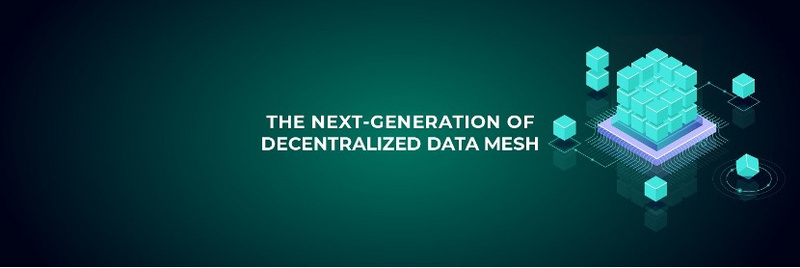
Stratos -- Next-Generation Decentralized Data Network.
The Stratos network provides decentralized storage solutions and launched its storage testnet in February this year, with the mainnet expected to go live this year. Stratos is based on a powerful decentralized platform and a high-throughput native blockchain, with investments from Fundamental Labs, Kenetic, Fenbushi Capital, Assembly Partners, and others.
The Stratos network consists of four modules and three layers, providing developers with the underlying infrastructure. The four modules are blockchain, decentralized storage, decentralized database, and decentralized computing. The three layers are the value layer, resource layer, and metadata routing layer, each associated with a different consensus method. The value layer uses Proof-of-Stake (PoS) consensus, the resource layer uses Proof-of-Traffic (PoT) consensus, and the metadata routing layer uses Proof-of-Authority (PoA) consensus.
6.4 Ceramic
Ceramic is a decentralized open-source platform for creating, hosting, and sharing data, originally known as 3Box, a user identity data protocol based on Ethereum. It provides computation, state transitions, and consensus synchronization for all types of data structures stored on decentralized networks, extracting variable dynamic data from static and immutable data on storage protocols.
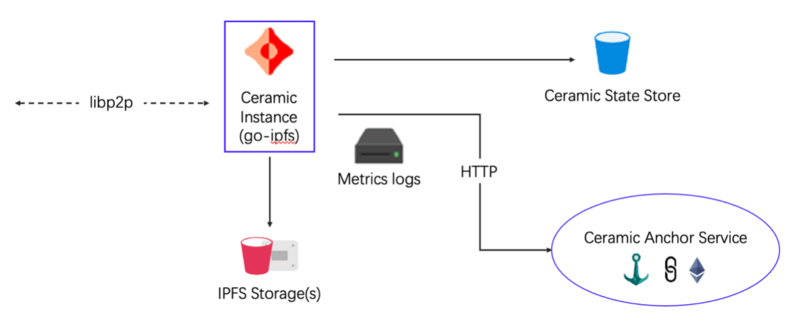
Ceramic Node Stack (Source: CoinOn)
Ceramic aims to address the apparent shortcomings of IPFS, namely that once files are stored, they cannot be updated in real-time and require manual synchronization, which is inefficient. The data stream process of Ceramic enables developers to build secure, trustless, censorship-resistant Dapps based on dynamic information without a trusted database server. The core components of Ceramic include three:
Scalable, decentralized data infrastructure;
Open APIs for storing, modifying, and retrieving data;
A community-created reusable data model marketplace.
6.5 Crust Network

Crust Network is a parachain of Polkadot, aimed at providing decentralized cloud storage services. As an important storage public chain in the Polkadot ecosystem, Crust Network is expected to become a crucial part of Web3 infrastructure development. The unique design of Crust Network mainly includes two points: MPoW (Meaningful Proof of Work) and GPoS (Guaranteed Proof of Stake).
MPoW effectively addresses the reporting issues of node workload, characterized by transparency, fairness, efficiency, and development potential. In simple terms, the storage mechanism is simple and transparent, with miner workload proportional to rewards, efficiently utilizing storage space, and TEE development having unlimited potential. Under the GPoS consensus mechanism, the Crust Network ecosystem generates four roles: validators, candidates, guarantors, and users.
Validators are nodes that package and generate blocks in the network, maintaining the entire blockchain network, requiring storage assets as collateral, and needing to be online in real-time, similar to miner nodes in the Filecoin network.
Candidates are nodes competing to become validators but ultimately do not qualify, also needing storage assets as collateral and requiring real-time online presence. However, the role of candidates is not fixed, and candidates have the opportunity to become validators.
Guarantors are accounts that provide guarantees for any one or more nodes in the network, earning guarantee income for providing collateral.
Users are the main body of storage demand, purchasing storage services by paying CRU and other tokens from the Crust Network, utilizing the network's storage space.
About MEKO CLUB DAO
MEKO CLUB DAO------a DAO organization focused on cutting-edge information, in-depth reporting, and creative asset monetization in the global creator economy (games, music, art, creativity, knowledge).
MEKO = ME Collaborating with the worldwide creators
Our vision: To ensure that the value of products and services provided by creators is reasonably priced and rewarded in the metaverse.
Our mission: To help overseas projects establish Chinese communities, assist Chinese teams in connecting with overseas resources, and help creators and users become mainstream Web3.0 players.
Our values: As explorers and builders in the WEB3 industry, we uphold objectivity, integrity, sincerity, innovation, mutual learning, and proactive engagement; caring for ourselves, colleagues, partners, and the DAO organization, striving to improve the lives of ourselves and DAO members.









